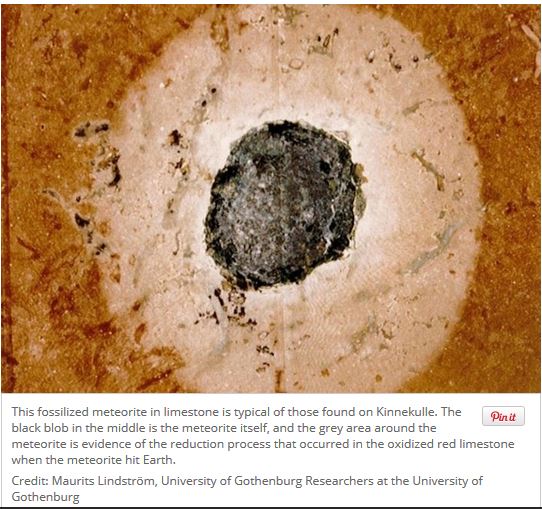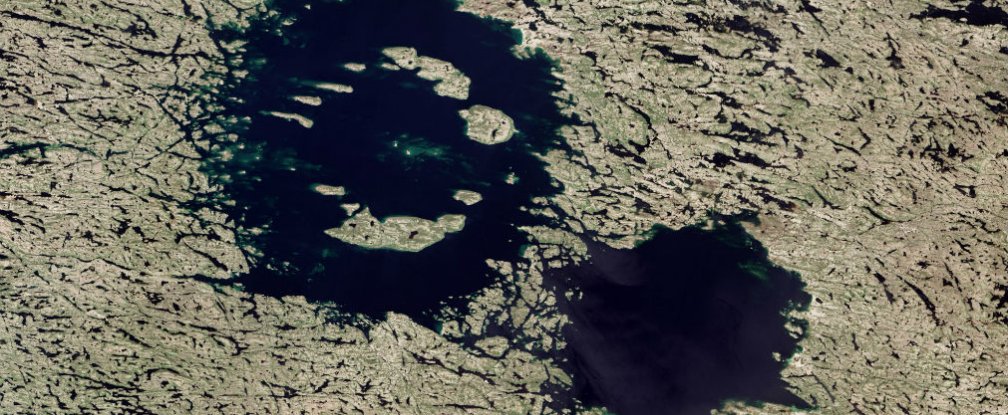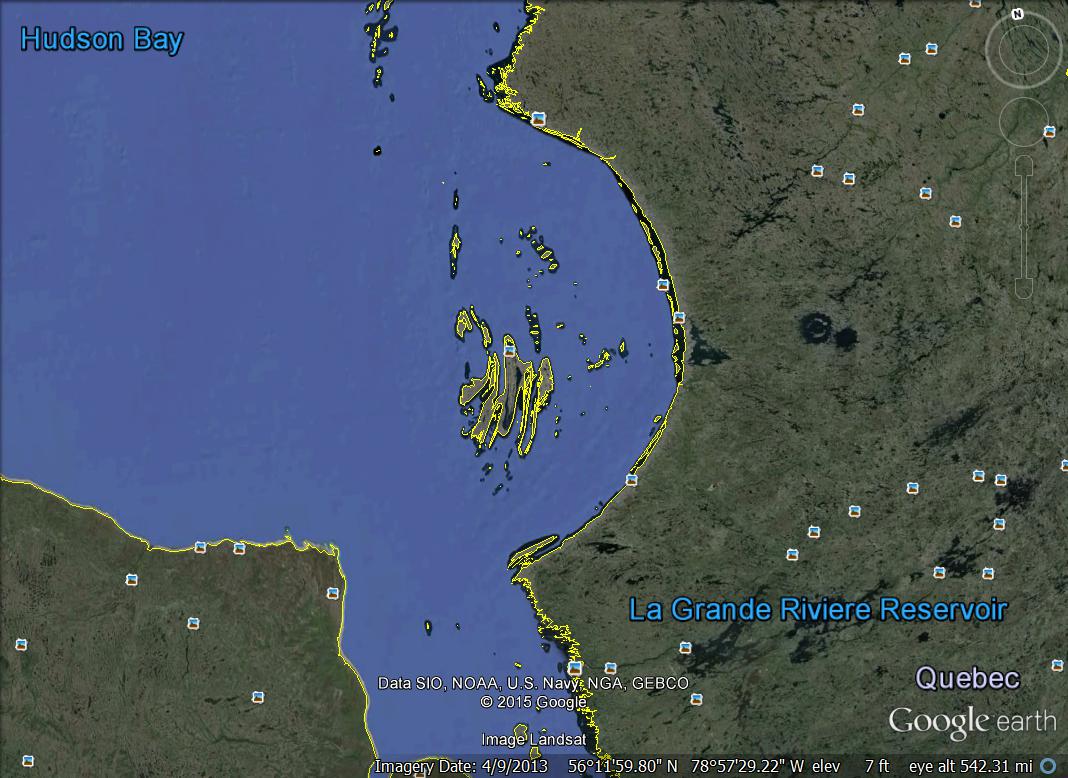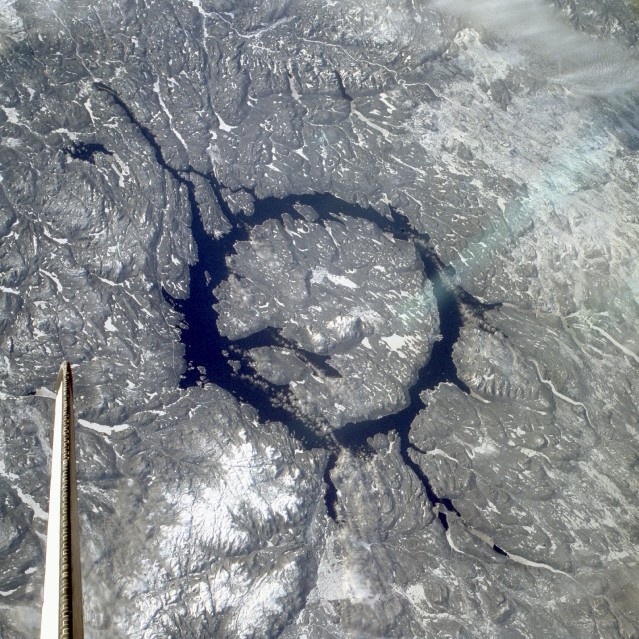It looks like you're using an Ad Blocker.
Please white-list or disable AboveTopSecret.com in your ad-blocking tool.
Thank you.
Some features of ATS will be disabled while you continue to use an ad-blocker.
5
share:
Hey this is pretty cool stuff. I've never heard of two meteors striking at the same time, especially, just 10 miles apart. Well some researches say
it happened 458 million years ago in Sweden. One of the craters was huge, measuring 4.5 miles across. The other was a measly 2300 ft. across. Still,
some severe, costly, Life ending damage in today's world. Here's some of what they had to say.
Here's a snip/shot of the meteor in limestone.

I think that's really interesting and if it happened once...Sure it happened or can happen again?! The article goes on..
Geology! Rocks, hold the answers!
Well that's that. I thought the article was very interesting and a nice break from the DooM! If you like to read more here's the link.
LiveScience
It's not altogether uncommon to hear about double rainbows, but what about a double meteor strike? It's a rare event, but researchers in Sweden recently found evidence that two meteors smacked into Earth at the same time, about 458 million years ago. Researchers from the University of Gothenburg uncovered two craters in the county of Jämtland in central Sweden. The meteors that formed the craters landed just a few miles from each other at the same moment, according to Erik Sturkell, a professor of geophysics at the University of Gothenburg and one of the scientists who is studying the newfound craters. When the meteors slammed into Earth, Jämtland was just a seafloor, about 1,600 feet (500 meters) below the surface of the water. One of the craters left by the meteors is huge, measuring 4.7 miles (7.5 kilometers) across. The other, smaller crater — which is only about 2,300 feet (700 m) across — is located just 10 miles (16 km) from its larger neighbor.
Here's a snip/shot of the meteor in limestone.

I think that's really interesting and if it happened once...Sure it happened or can happen again?! The article goes on..
After analyzing information collected from a drilling operation, the researchers determined that the impact craters were formed at the same time. The information revealed identical geological sequences, or layers of rock, inside each crater. The sediment that accumulated inside the craters over the subsequent millennia also dates back to the same time, according to Sturkell. "In other words, these are simultaneous impacts," Sturkell said in a statement. The meteors likely crashed to Earth following the collision of two large asteroids in the asteroid belt between Mars and Jupiter some 470 million years ago, he added.
Geology! Rocks, hold the answers!
When the meteors crashed into Earth, they displaced the water underneath them, leaving two huge, dry pits in the seabed for about 100 seconds, the researchers said. "The water then rushed back in, bringing with it fragments from the meteorites mixed with material that had been ejected during the explosion and with the gigantic wave that tore away parts of the seabed," Sturkell said. This isn't the first time that scientists in the area have found evidence of ancient meteor impacts in what is now Sweden, though it is the first time they've found evidence of two meteors striking the planet at the same moment.
Well that's that. I thought the article was very interesting and a nice break from the DooM! If you like to read more here's the link.
LiveScience
They were both probably the same rock before splitting right before impact
a reply to: Journey1986
I was thinking the same, shortly before impact, they separated. rather than a cluster.
I was thinking the same, shortly before impact, they separated. rather than a cluster.
originally posted by: Journey1986
They were both probably the same rock before splitting right before impact
I disagree.... the big chunk was likely hit by a second object and the smaller chunk became Its' own satellite while they were still in the Asteroid Belt.... and the mini-system (host body asteroid and Its' satellite) remained a pair of meteorites as they sped Earthward from beyond Mars and then through the atmosphere above Sweden...
the 10 mile distance between the impacts could possibly be accounted for in just a second or so of separation at high altitude and angle of entry into the atmosphere
I don't see the necessity of the meteorite breaking apart only after getting heated up upon hitting the atmosphere, that - I think - would most likely result in the smaller chunk of rock being merely swept up in the larger objects wake as the pair pierced through the thicker atmosphere in a orderly string of objects
edit on th30144233826815312015 by St Udio because: (no reason given)
a reply to: St Udio
I'm no scientist, and only know from what I've seen on TV and in movies, but isn't making it through the atmosphere something akin to threading a needle? I thought that just the slightest variance in trajectory could have the second, satellite meteor bounce off the atmosphere. That's why, in my uneducated mind, theorizing that the original meteor split in two makes more sense to me.
I'm no scientist, and only know from what I've seen on TV and in movies, but isn't making it through the atmosphere something akin to threading a needle? I thought that just the slightest variance in trajectory could have the second, satellite meteor bounce off the atmosphere. That's why, in my uneducated mind, theorizing that the original meteor split in two makes more sense to me.
edit on 15-9-2015 by windword because: (no reason given)
originally posted by: Journey1986
They were both probably the same rock before splitting right before impact
Imagine the speed of the meteorite: 25,000 to 80,000 mph relative to Earth (or 6 to 22 miles per second) . Earth's atmosphere is 100 miles deep. In a matter of seconds, a massive shockwave and bubble of plasma would have formed in front of the meteorite. That would melt the surface and cause explosive expansion of any liquids or gases inside. That would cause the meteorite to split apart. In those last few seconds, that would be enough to change the trajectory of both fragments enough to separate them by ten miles or more.
a reply to: Hijinx
touchy, touchy! I am sorry I lost your respect!! truly I am.. Not as sorry about forgetting to insert a sarcasm, indicator in my post. You see, I do that a lot. Sarcasm... Yes I agree 2300' would be devastating. A game changer. opps I better speak clearly. A world Changer. I do hope, you can find it in ya, to have a fantastic rest of your evening!
touchy, touchy! I am sorry I lost your respect!! truly I am.. Not as sorry about forgetting to insert a sarcasm, indicator in my post. You see, I do that a lot. Sarcasm... Yes I agree 2300' would be devastating. A game changer. opps I better speak clearly. A world Changer. I do hope, you can find it in ya, to have a fantastic rest of your evening!
It happens all the time in the solar system. It probably happens more often than we know on Earth but Earth does a pretty good job of erasing craters so lots of impact records for Earth have been destroyed by geologic processes. According to this paper about 10% of the impacts on Venus and Earth are probably double impacts:
originally posted by: C21H30O2I
I think that's really interesting and if it happened once...Sure it happened or can happen again?! The article goes on..
www.boulder.swri.edu/~bottke/Reprints/Bottke_Binary_Icarus_1996.pdf
• About 15% of all Earth-crossing asteroids should have satellites, and fast-rotating rubble-piles are the most likely objects to undergo tidal fission and produce satellites.
• The steady-state binary asteroid population in the Earth-crossing asteroid region is large enough to produce the fraction of doublet craters found on Earth and Venus (p10%). We predict that the Moon has the same percentage of doublets.
In 1996 a crater chain of three craters was discovered...the third one wasn't known immediately as it was buried:
In Search of Crater Chains
Here are 14 craters that all formed at the same time on Jupiter's moon Ganymede:
In a remote windswept area named Aorounga, in Chad, there are three craters in a row, each about 10 km in diameter. "We believe this is a 'crater chain' formed by the impact of a fragmented comet or asteroid about 400 million years ago in the Late Devonian period," explains Adriana Ocampo of NASA headquarters.
Ocampo and colleagues discovered the chain in 1996. The main crater "Aorounga South" had been known for many years—it sticks out of the sand and can be seen from airplanes and satellites. But a second and possibly third crater were buried. They lay hidden until radar onboard the space shuttle (SIR-C) penetrated the sandy ground, revealing their ragged outlines.
"Here on Earth, crater chains are rare," says Ocampo, but they are common in other parts of the solar system.
Then there was Shoemaker-Levy-9 which impacted Jupiter in 1994, which was a "rubble pile" consisting of 21 fragments. If Jupiter had craters, that would have made 21 of them, but as a gas giant it has no craters.
edit on 2015917 by Arbitrageur because: clarification
a reply to: Arbitrageur
Arbitrageur, thanks for the info! I have heard/read about earth impacts being erased. Ya and the moon is littered with them. I guess, it is common. Very cool.
Arbitrageur, thanks for the info! I have heard/read about earth impacts being erased. Ya and the moon is littered with them. I guess, it is common. Very cool.
A spectacular double hit is the Clearwater lakes craters in northern Quebec, Canada .The western lake is about 36 kilometers wide (22.5 miles) with a
ring of islands in the center.


a reply to: C21H30O2I
(And,, thanks OP, hope you do not mind to my contributing, as multiple impact events are really cool, and I have studied many.)
Earlier this year, a University of Ontario geologist tried to convince us that this was not a binary hit, and was separated by millions of years. The original observation still stands however. Just the odds of 2 near each other, and with an East-West orientation.... Multiple impact events occur with the objects lined up behind each other. The movement of the Earth beneath the incoming objects produces the multiple crater displacements. In the case of the Clearwater impacts, they are separated by about 20 miles. The smaller one hit first, and the larger one about 1.5 minutes later.
Now, look to the left of the Clearwater pair, and see something that could be just astounding. Hudson Bay.
Looks like the edge of a crater , does it not? .. and remnants of the central ring in the islands off shore... This is still being analysed today as a possible HUGE impact site, but it is so old, that it may never be truly classified because they cannot locate shocked quartz, shatter cones or impact breccia that definitevely points to this being an impact.... yet.

Another suspected multiple impact crater involves Manicouagan Reservoir, Quebec, Canada. But the impactors were stretched so far apart that the multiple craters are spread around the world.
One thing for sure, Quebec has a real impact legacy...
This picture of Manicouagan was taken by the space shuttle.

(And,, thanks OP, hope you do not mind to my contributing, as multiple impact events are really cool, and I have studied many.)
Earlier this year, a University of Ontario geologist tried to convince us that this was not a binary hit, and was separated by millions of years. The original observation still stands however. Just the odds of 2 near each other, and with an East-West orientation.... Multiple impact events occur with the objects lined up behind each other. The movement of the Earth beneath the incoming objects produces the multiple crater displacements. In the case of the Clearwater impacts, they are separated by about 20 miles. The smaller one hit first, and the larger one about 1.5 minutes later.
Now, look to the left of the Clearwater pair, and see something that could be just astounding. Hudson Bay.
Looks like the edge of a crater , does it not? .. and remnants of the central ring in the islands off shore... This is still being analysed today as a possible HUGE impact site, but it is so old, that it may never be truly classified because they cannot locate shocked quartz, shatter cones or impact breccia that definitevely points to this being an impact.... yet.

Another suspected multiple impact crater involves Manicouagan Reservoir, Quebec, Canada. But the impactors were stretched so far apart that the multiple craters are spread around the world.
- Source: WP
It has been suggested that the Manicouagan crater may have been part of a multiple impact event which also formed the Rochechouart crater in France, Saint Martin crater in Manitoba, Obolon' crater in Ukraine, and Red Wing crater in North Dakota.
One thing for sure, Quebec has a real impact legacy...
This picture of Manicouagan was taken by the space shuttle.

edit on 18-9-2015 by charlyv because: (no reason given)
edit on 18-9-2015 by charlyv because: s
edit on
18-9-2015 by charlyv because: content
new topics
-
Thousands Of Young Ukrainian Men Trying To Flee The Country To Avoid Conscription And The War
Other Current Events: 1 hours ago -
12 jurors selected in Trump criminal trial
US Political Madness: 3 hours ago -
Iran launches Retalliation Strike 4.18.24
World War Three: 3 hours ago -
Israeli Missile Strikes in Iran, Explosions in Syria + Iraq
World War Three: 4 hours ago -
George Knapp AMA on DI
Area 51 and other Facilities: 10 hours ago -
Not Aliens but a Nazi Occult Inspired and then Science Rendered Design.
Aliens and UFOs: 10 hours ago
top topics
-
BREAKING: O’Keefe Media Uncovers who is really running the White House
US Political Madness: 17 hours ago, 25 flags -
George Knapp AMA on DI
Area 51 and other Facilities: 10 hours ago, 25 flags -
Israeli Missile Strikes in Iran, Explosions in Syria + Iraq
World War Three: 4 hours ago, 13 flags -
Louisiana Lawmakers Seek to Limit Public Access to Government Records
Political Issues: 12 hours ago, 7 flags -
So I saw about 30 UFOs in formation last night.
Aliens and UFOs: 15 hours ago, 6 flags -
Iran launches Retalliation Strike 4.18.24
World War Three: 3 hours ago, 5 flags -
Not Aliens but a Nazi Occult Inspired and then Science Rendered Design.
Aliens and UFOs: 10 hours ago, 5 flags -
Do we live in a simulation similar to The Matrix 1999?
ATS Skunk Works: 16 hours ago, 4 flags -
The Tories may be wiped out after the Election - Serves them Right
Regional Politics: 13 hours ago, 3 flags -
12 jurors selected in Trump criminal trial
US Political Madness: 3 hours ago, 2 flags
active topics
-
President BIDEN Warned IRAN Not to Attack ISRAEL - Iran Responded with a Military Attack on Israel.
World War Three • 43 • : WeMustCare -
Israeli Missile Strikes in Iran, Explosions in Syria + Iraq
World War Three • 52 • : WeMustCare -
Mandela Effect - It Happened to Me!
The Gray Area • 107 • : inflaymes69 -
Terrifying Encounters With The Black Eyed Kids
Paranormal Studies • 45 • : daskakik -
Not Aliens but a Nazi Occult Inspired and then Science Rendered Design.
Aliens and UFOs • 12 • : BeyondKnowledge3 -
Elites disapearing
Political Conspiracies • 31 • : Degradation33 -
MULTIPLE SKYMASTER MESSAGES GOING OUT
World War Three • 47 • : SchrodingersRat -
12 jurors selected in Trump criminal trial
US Political Madness • 21 • : VictorVonDoom -
British TV Presenter Refuses To Use Guest's Preferred Pronouns
Education and Media • 64 • : Degradation33 -
Iran launches Retalliation Strike 4.18.24
World War Three • 14 • : Cloudbuster1
5

